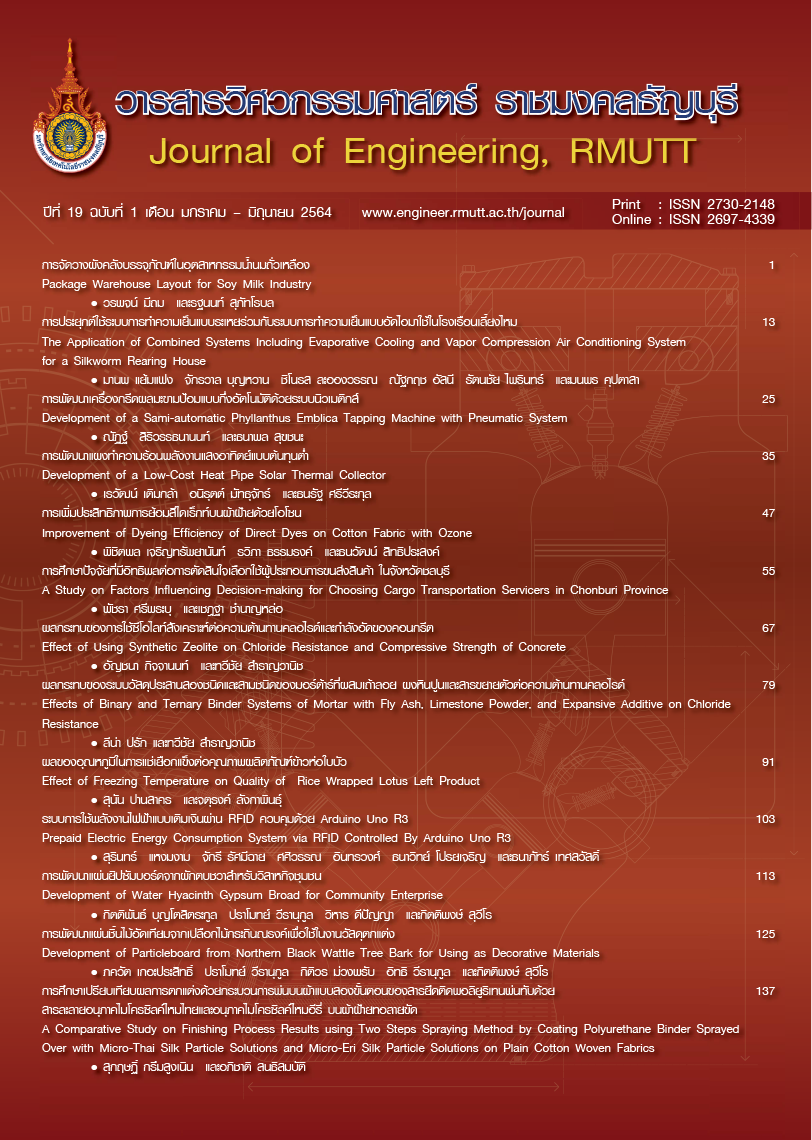การพัฒนาแผ่นยิปซัมบอร์ดจากผักตบชวาสำหรับวิสาหกิจชุมชน
Main Article Content
บทคัดย่อ
งานวิจัยนี้มีวัตถุประสงค์เพื่อพัฒนาแผ่นยิปซัมบอร์ดจากผักตบชวา ทำการออกแบบส่วนผสมของแผ่นยิปซัม จำนวน 9 อัตราส่วน ประกอบด้วย แผ่นยิปซัมผสมเส้นใยผักตบชวา จำนวน 3 อัตราส่วน แผ่นยิปซัมผสมเส้นใยผักตบชวาและปูนซีเมนต์ปอร์ตแลนด์ จำนวน 3 อัตราส่วน แผ่นยิปซัมผสมเส้นใยผักตบชวา ปูนซีเมนต์ปอร์ตแลนด์ และน้ำยางพาราชนิดพรีวัลคาไนซ์ จำนวน 3 อัตราส่วน ขึ้นรูปด้วยการเทหล่อในแบบ ทดสอบสมบัติตามมาตรฐาน มอก.219-2552 (ประเภทไม่ทนความชื้น) จากผลการทดสอบสรุปได้ว่า การผสมผักตบชวาในปริมาณที่เหมาะสมลงในแผ่นยิปซัมมีผลทำให้สมบัติด้านความหนาแน่น การดูดซึมน้ำ และสัมประสิทธิ์การนำความร้อนมีแนวโน้มลดลง และทำให้สมบัติด้านแรงกดแตก และแรงต้านทานการดึงตะปูมีแนวโน้มเพิ่มขึ้น โดยอัตราส่วนของแผ่นยิปซัมบอร์ดจากผักตบชวาที่เหมาะสมและมีสมบัติผ่านตามที่มาตรฐานกำหนด คือ แผ่นยิปซัมบอร์ดจากผักตบชวาที่มีส่วนผสมของยิปซัมปาสเตอร์ ปูนซีเมนต์ปอร์ตแลนด์ประเภท1 เส้นใยผักตบชวา น้ำยางพาราชนิดพรีวัลคาไนซ์ สารลดแรงตึงผิวชนิดไม่มีประจุ และน้ำประปา ในอัตราส่วนเท่ากับ 0.75: 0.25: 0.0075: 0.05: 0.003: 1 ส่วนโดยน้ำหนัก ตามลำดับ โดยมีสมบัติ ได้แก่ ความหนาแน่น 896.30 กิโลกรัมต่อลูกบาศก์เมตร การดูดซึมน้ำร้อยละ 51.70 การดูดซึมน้ำที่ผิว 219.58 กรัมต่อตารางเมตร แรงกดแตกตามยาว 653.50 นิวตัน แรงกดแตกตามขวาง 384.41 นิวตัน แรงต้านการดึงตะปู 422.37 นิวตัน การแอ่นตัว 4.48 มิลลิเมตร และสัมประสิทธิ์การนำความร้อน 0.195 วัตต์ต่อเมตร.เคลวิน แผ่นยิปซัมดังกล่าวสามารถใช้งานได้เช่นเดียวกับแผ่นยิปซัมทั่วไปและวิสาหกิจชุมชนสามารถผลิตได้
Article Details
บทความ ข้อมูล เนื้อหา รูปภาพ ฯลฯ ที่ได้รับการตีพิมพ์ในวารสารแนวหน้าวิจัยนวัตกรรมทางวิศวกรรม ถือเป็นลิขสิทธิ์ของวารสารฯ เท่านั้น ไม่อนุญาติให้บุคคลหรือหน่วยงานใดคัดลอกเนื้อหาทั้งหมดหรือส่วนหนึ่งส่วนใดไปเผยแพร่เพื่อกระทำการใด ๆ ที่ไม่ถูกต้องตามหลักจริยธรรม
เอกสารอ้างอิง
Weeranukul P, Suweero K., Weeranukul I. Coconut coir ceiling board product with thermal insulation property. Journal of Engineering, RMUTT. 2018;16(2):129-38. (in Thai)
Jindaprasert P, Jaturapitakkul C. Cement, Pozzolan, and Concrete. Bangkok: ACI Partners with Thailand Concrete Association; 2012. (in Thai)
Ohama Y. Principle of latex modification and some typical properties of latex-modified mortars and concretes. ACI Materials Journal. 1987; 84(45):511-8.
Weeranukul P, Suweero K, Weeranukul I. Coconut coir ceiling board product with water resistance and thermal insulation property for local communities. Proceedings of the 11th National Conference of Rajamangala University of Technology; 2019 Jul 24-26; Chiang Mai: Chiang Mai International Convention and Exhibition Centre. Chiang Mai: Rajamangala University of Technology Lanna; 2019. p.244-59. (in Thai)
Khamput P. Study of physical and mechanical of concrete block mixed with Para latex. Full Report. Bangkok: Thailand Research Fund; 2007. (in Thai)
The Secretariat of the Prime Minister. Water Hyacinth [Internet]. Bangkok: The Secretariat of the Prime Minister. 2020 May 20 [cited 2020 Oct 1]. Available from: https://spm.thaigov.go.th/CRTPRS/spm-sp-layout6.asp?i=31111%2E13614702112113121111311. (in Thai)
Ghosh SR, Saikia DC, Goswami T, Chaliha BP, Baruah JN. Utilization of water hyacinth (Eichhornia crassipers) for paper and board making. Proceedings of the International Conference on Water Hyacinth; 1984 Feb. 7-11; Nairobi: UNEP: UNEP; 1984. p.436-60.
Thai Industrial Standards Institute (TISI). Thai Industrial Standard No.219-2009: Gypsum Board. Bangkok: TISI; 2009. (in Thai)
American Society for Testing and Materials (ASTM). Annual Book of ASTM Standards. Philadelphia: ASTM; 2012.
Davies RM, Mohammed US. Moisture-dependent Engineering Properties of Water Hyacinth Parts. Singapore Journal of Scientific Research. 2011;1:253-63.
Faherty KF, Williamson TG. Wood Engineering and Construction Handbook. New York: McGraw-Hill, Inc.; 1995.
Young HD. Hyper Physics. Addison Wesley: University Physics.; 1992.
Barlow FW. Rubber Compounding: Principles, Materials, and Techniques. New York: M. Dekker; 1993.
Sair S, Mandili B, Taqi M, Bouari AE. Development of a new eco-friendly composite material based on gypsum reinforced with a mixture of cork fibre and cardboard waste for building thermal insulation. Composites Communications. 2019;16:20–4.
Bledzki AK, Gassan J. Composites Reinforced with Cellulose based Fibers. Progress in Polymer Science. 1999;24:221-74.
Park JH, Kang Y, Lee J, Wi S, Chang JD, Kim S. Analysis of walls of functional gypsum board added with porous material and phase change material to improve hygrothermal performance. Energy and Buildings. 2019;183(1):803-16.
Clemens JML. Design, Materials, Compounds, Adhesives, and Substrates [Internet]. PA: Lectrix. 2001 Nov 1 [cited 2020 Oct 1]. Available from: https://www.electronics-cooling.com/2001/11/the-thermal-conductivity-of-rubbers-elastomers/#.
Pakunworakij T, Puthipiroj P, Oonjittichai W, Tisavipat, P. Thermal resistance efficiency of building insulation material from agricultural waste. Journal of Architectural/Planning Research and Studies. 2006;3(4):119-26. (in Thai)


